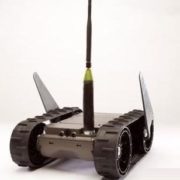Unmanned Ground Vehicles (UGV) don’t get much love. Their aerial cousins, usually described by the technically inaccurate term “drone,” receive much more publicity, as well as greater funding. UGV developers fear that the Defense budget squeeze will disproportionately affect them.
However, one federal agency still believes in promoting UGV development. Defense Advanced Research Projects Agency (DARPA) is sponsoring the DARPA Robotics Challenge, “… a competition of robot systems and software teams vying to develop robots capable of assisting humans in responding to natural and man-made disasters.” In addition to a $2 million prize for the top contestant, this challenge represents a wonderful opportunity to explore capabilities and for developers to network.
Jessica L. Tozer, writing for Armed with Science (Department of Defense’s science blog,) does an excellent job describing the challenges of this competition as well as listing the pre-qualified teams. The following article, written by her, originally appeared as a blog post titled Here comes the Robots.
———————————
“…you just can’t differentiate between a robot and the very best of humans.” – Issac Asimov, I, Robot
DARPA is doing a lot of great things in the way of robotics, but none gets more attention than the DRC, the DARPA Robotics Challenge. The reason being the fact that these robots, for all intents and purposes, are being designed to be the first line of defense in the midst of tragedies too dangerous for humans to tread.
I’ve watched the contestants in the robotics challenge form and develop from concept, to creation, to competition and now, with the 3rd and final part of the robotics challenge about to start, it’s nearing the grand finale that we’ve been waiting two years to witness.
But before we get into how the world is about to enter into the era of robots (and if you think I’m joking, I’m not) let’s talk about where we are in a practical sense. I say this because the moment we start talking about this, people scream protests with words like “Skynet” and “Cylons” and let’s just, you know, calm down for a moment.
Here’s the breakdown of the DARPA Robotics Challenge:
1. The goal of the robotics challenge is to develop ground robotics capabilities. “We’re executing complex tasks and dangerous degraded human engineer environments such as occurrences and disasters,” explains Dr. Gill Pratt, program manager for the DRC, explained during a recent media roundtable.
“We’re doing this to protect lives during man made and natural disasters.”
2. These robots do not operate on their own. Sorry, guys, but DARPA is not a modern-day Dr. Noonien Soong or anything. “What we do is we partner them with operators that supervise the robots,” Gill explains. “In a disaster, you might imagine that there is an operator who is a small distance from the disaster zone. They are connected through some communication link to the robot that is in the disaster zone, and that human is supervising the action of the robot.”
3. It’s all about teamwork. No, seriously. “What I’m really talking about is a human/robot team collaborating to try to be effective in mitigating a disaster,” Gill says. “What’s so good about it is the robot can do what its best at – which is being able to survive the difficult conditions in the disaster – and the human being can do what they’re best at, which is to use human perception and human planning and human experience in order to tell the robot what to do.”
Because of the remarkable success at the 2nd round of trials in December of last year, Gill Pratt says that this 3rd round is going to raise the bar. Due to their participation and scores during the 2013 DRC Trials, the following teams are pre-qualified to participate in the DRC Finals: Atlas-Ian (IHMC Robotics), CHIMP (Tartan Rescue), HELIOS (MIT), RoboSimian (RoboSimian), Hercules (Team TRACLabs), WARNER (Team WPI-CMU), Atlas (Team TROOPER), DRC-HUBO (Team KAIST), THOR-OP (Team THOR), THOR (Team VALOR), and Florian (Team ViGIR).
Interestingly, we’re told that the team that actually came in first in the trials, Team Shaft, has elected to withdraw from the finals. They are instead going to be focusing on the development of their first commercial project.
Due to the consideration of the teams involved, and the allowance for time and effort to be best utilized, DARPA has changed the dates and times for the final event. Unlike the 2nd round of trials, which were in Florida, this one is going to be in Pomona, California. The date for the final event is going to be June 5- June 6 of 2015. That’s roughly 6 months after the initial plan that we had to do it, but Gill says the extra time for effort will be worth the wait.
The reason, Gill says, is two-fold. One is DARPA’s interest in working with other countries internationally on developing disaster relief robots, and the other is the fact that there has been a new concept in robotic autonomy which is being called “cloud robotics”.
“We want to exploit cloud robotics, and also the investments coming from other parts of the world,” Gill explains. “In a way, that is actually applicable to disaster responses.”
He goes on to say that they’re not going to try to replicate what the commercial world is about to do. Rather, DARPA – and their partners – are going to do the opposite.
“We’re going to do the work that we think the commercial sector is not going to do. In particular, problems that are unique to disaster response, so operation without the possibility of physical human intervention if something goes wrong.”
Typically, in a disaster, if you’re using a robot in the first place it’s because the environment is pretty harsh. Like, nuclear meltdown harsh. You’re likely going to need to deal with the serious problem, but you can’t send a person in to do it. This is where the robot, theoretically, steps in.
You have to make sure the robot will continue to work well in any scenario, even (and especially) if there is no way for a human being to be able to physically go there to help out.
The tasks of the 3rd and final round of trials are going to be similar in what we saw in the trials, but instead of eight separate tasks (e.g. opening a door, walking up stairs, etc), the contestants will be slowly putting together all the tasks to create a sequence.
 Something that, Gill Pratt points out, would be more authentic to what a disaster would be like.
Something that, Gill Pratt points out, would be more authentic to what a disaster would be like.
For instance, say you have to drive the vehicle to the site of a disaster. You have to get out of the vehicle, you have to climb up the steps, go over the rough ground, and each step follows the next. Sounds easy enough for a human, but for a robot, it’s a daunting undertaking. That said, the robot must take these steps, in order, to be able to make it through to the next challenge.
Another big difference is the robots will not be connected to power cords or any other wire communication (tethers).
They’re going wireless! To do this, they’re going to use wireless tubes to communicate with the robots themselves. That said, there won’t be any other kind of physical support, and no other power sources. All the power will have to be onboard. Oh, and human beings will not be able to physically intervene.
“If a robot falls or gets stuck the full fall would have to occur without breaking something on the robot that is vital to continue its operation, and the robot will have to be able to get up without assistance,” said Gill Pratt.
So let’s talk about speed. Speed, you may have noticed, is a bit on the slow side when it comes to robots. They’re not as quick-on-the-draw as you would expect, leaping and bounding from one event to the next. Simply put, robots use up a lot of power, and that makes them move slowly and deliberately.
Ideally, DARPA is hoping to have all eight sequential tasks at the final trial completed within one hour, which, by the way, is about four times faster than they were going in the previous trial.
The robots will be judged on their ability to communicate when communication capability is degraded or limited. Again, this is aiming toward being authentic re: actual disasters. “We will be making the communication fully intermittent,” Gill explains, “which means were going to be turning it on and off in a way that you might have on a cell phone call when suddenly the call is gone and in a few seconds the call comes back. In the trials we degraded the bandwidth so that it slowed things down. We had latency, and were going to continue with the latency. [This time] we’re actually going to lower the bandwidth all the way to 0 at times so the robots will, in fact, need to deal with this very difficult communication environment.”
“We will be making the communication fully intermittent,” Gill explains, “which means were going to be turning it on and off in a way that you might have on a cell phone call when suddenly the call is gone and in a few seconds the call comes back. In the trials we degraded the bandwidth so that it slowed things down. We had latency, and were going to continue with the latency. [This time] we’re actually going to lower the bandwidth all the way to 0 at times so the robots will, in fact, need to deal with this very difficult communication environment.”
Finally, the last challenge for the final round of trials is going to be a SURPRISE! Yes, that’s correct. We’re going to have a secret-level event, for which not even the contestants know the details.
Don’t let that get you down, though, contestants. They’re still a cool $2 million dollar prize for the highest ranking team. It clearly pays to be in the running for the most epic robot competition of all time.
Want to be a part of the action, but not a big government agency? You’re in luck! There is a qualification event on Feb 2nd, 2015. Any team that wants to make the list and join in the competition only has to send DARPA a video to them on the Internet of your robot performing a set of basics that they will specify. If your robot has the moves, you will be qualified to join the finals that will occur in June of 2015.
So, will robots ever be able to perform these tasks for themselves? Well, perhaps someday, but I think it’s a bit of a reach, what with the June deadline and all.
While I’ve often said that science fiction is the aperture for science future, I don’t think we’re quite at a Mr. Data-level yet. Though that’s not to say we’re not making our way to more independent-working machines.
“It’s not that the robots don’t have any smarts on them at all,” Gill Pratt elaborates. “They actually do have the equivalent of the spinal cord, the beginning of the retina, and a little bit of primitive ways of planning one foot step after the other. They don’t really perceive, they don’t really understand, and they don’t really plan. We need human beings to do that.”
Yeah. For now.
Watch out, world. Here come the ROBOTS.
Keep track of the DRC trials by going here: www.theroboticschallenge.org
Disclaimer: The appearance of hyperlinks does not constitute endorsement by the Department of Defense of this website or the information, products or services contained therein. For other than authorized activities such as military exchanges and Morale, Welfare and Recreation sites, the Department of Defense does not exercise any editorial control over the information you may find at these locations. Such links are provided consistent with the stated purpose of this DOD website.









